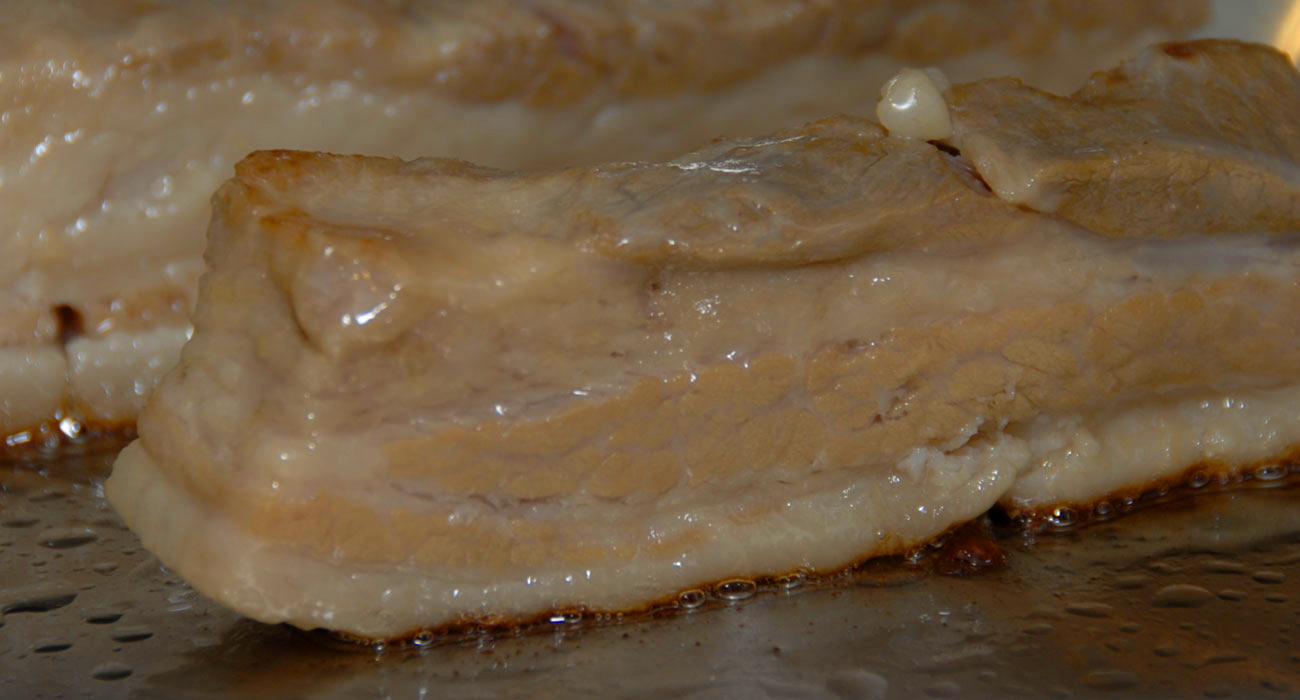
Pork belly confit
Following our love for good food, last week we adventured to the magic of pork belly confit. Pork belly is a tough muscle, so it must first braised or confited for hours to tenderize it. Then it can be sliced into smaller pieces and sauteéd to form a delicious crisp exterior while the center remains tender and juice.
This recipe was done following instructions on the book Ad Hoc at home by Thomas Keller.
YOU WILL NEED
Pork brine, cold
One 2 1/2 pound slab pork belly with skin
About 6 cups lard (3 pounds)
Canola oil
Gray salt or coarse sea salt
Pork brine
1/4 cup plus 2 tablespoons honey
12 bay leaves
3 large rosemary sprigs
1/2 bunch thyme (1/2 ounce)
1/2 bunch flat-leaf parsley (about 2 ounces)
1/2 cup garlic cloves, crushed, skin left on
2 tablespoons black peppercorns
1 cup kosher salt
8 cups water
Combine the ingredients in a large pot, cover, and bringing to a boil. Boil for 1 minute, stirring to dissolve the salt. Remove from the heat and cool completely, then chill before using. The brine can be refrigerated for up to 3 days. This amount of brine is ideal for up to 4 pounds of pork.
HOW TO DO IT
1. Pour the brine into a container large enough to hold the pork belly and add the pork. Refrigerate for 10 hours.
2. Remove the pork belly (discard the brine) and rinse under cold water. Pat dry with paper towels, or let air-dry.
3. Preheat the oven to 200°F
4. Choose an ovenproof pot, such a 12- quart Dutch oven, that is only slightly larger than the pork belly and has a lid; the pot should be large enough that the pork will be surrounded by the lard. Put the belly in the pot and cover with the lard; the lard should cover the pork by 1/2 to 3/4 in.
5. Heat the pot over low heat until the lard registers 190°F. Cover, transfer to the oven, and cook until the pork is
tender; this will probably take 5 1/2 to 6 hours, but start checking after 4 hours. As the belly cooks, it will lose fat and shrink;
it is best to transfer the meat and fat to a smaller pot, always keeping the belly covered by fat.
6. Remove the pot from the oven and let cool to room temperature. The belly can simply be refrigerated in its fat, but we prefer to press it to compress the internal layers of connective tissue and force out some of the excess fat, resulting in a better texture and appearance. To press it, transfer it to a deep baking dish. Pour enough fat into the dish to just cover the belly. Cover with plastic wrap, top with a smaller baking dish, and weight it down with a brick or large can. Refrigerate for at least 12 hours; reserve the extra fat. Once it’s been pressed, the pork belly can be refrigerated, covered by fat, for up to 1 week.
7. To serve, remove the pot from the refrigerator and let sit in a warm spot to soften the fat for 2 to 3 hours. You want to soften the fat enough so you can scrape it from the belly while keeping the belly as cold as possible so it will be easier to slice.
8. Remove the pork belly from the fat, and wipe off any cooking fat that clings to the meat. Remove the skin and score the fat on the belly in a crosshatch pattern. The belly can be cut into any shape. Slice it or cut it into squares, and let sit a room temperature for 20 to 30 minutes before sautéing. (The fat can be reused to confit pork belly several more times as long as it does not taste too salty. Pour it into a pot and heat gently to liquefy, then strain a fine-mesh conical strainer into a storage container. Refrigerate for up to 2 months or freeze for up to 6 months)
9. Preheat the oven to 350°F.
10. Heat some canola oil in a large ovenproof frying pan over medium-high heat just until smoking. Put the pieces of belly fat-side-down in the skillet, reduce the heat to medium-low, and cook until the excess of fat is rendered and the fat side is browned, about 18 minutes; pour off excess fat about halfway through the cooking.
11. When the pork is browned, transfer the pan to the oven to heat through, about 10 minutes. Remove from the oven, sprinkle with gray salt and serve.

No Comments